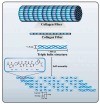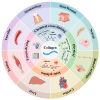Recent Advances in the Development and Application of Cell-Loaded Collagen Scaffolds
- PMID: 40362249
- PMCID: PMC12071569
- DOI: 10.3390/ijms26094009
Recent Advances in the Development and Application of Cell-Loaded Collagen Scaffolds
Abstract
Tissue engineering techniques aim to improve or replace biological tissues or organs by utilizing the extracellular matrix to facilitate the repair of damaged tissues or organs. Collagen-based scaffolds offer numerous advantages, including excellent biocompatibility, low immunogenicity, biodegradability, hemostatic properties, and mechanical strength. Collagen scaffolds can reconstruct the extracellular microenvironment, promote cell adhesion, migration, proliferation, and differentiation, and play a critical role in cell-to-cell and cell-to-matrix interactions. Collagen has been extensively utilized in tissue engineering to facilitate tissue repair and organ reconstruction. This review examines the properties of collagen, including its composition, structure, biological characteristics, and role in regulating various cellular behaviors. Additionally, the preparation of cell-loaded collagen scaffolds is discussed, along with a comprehensive overview of their applications in various tissues, including skin, nerve, bone/cartilage, heart, liver, and others. Emerging strategies and future perspectives for clinical tissue repair are also presented. This review provides a comprehensive synthesis of the mechanisms underlying the use of cell-loaded collagen scaffolds as advanced biomaterials, emphasizing their potential to expand the clinical applications of collagen.
Keywords: cell scaffolds; collagen; hydrogel; sponge; tissue engineering; tissue repair.
Conflict of interest statement
The authors declare no conflicts of interest.
Figures
Similar articles
-
Recent Development in the Fabrication of Collagen Scaffolds for Tissue Engineering Applications: A Review.Curr Pharm Biotechnol. 2019;20(12):992-1003. doi: 10.2174/1389201020666190731121016. Curr Pharm Biotechnol. 2019. PMID: 31364511 Review.
-
Collagen as a bio-ink for 3D printing: a critical review.J Mater Chem B. 2025 Feb 5;13(6):1890-1919. doi: 10.1039/d4tb01060d. J Mater Chem B. 2025. PMID: 39775500 Review.
-
Hybrid and Composite Scaffolds Based on Extracellular Matrices for Cartilage Tissue Engineering.Tissue Eng Part B Rev. 2019 Jun;25(3):202-224. doi: 10.1089/ten.TEB.2018.0245. Tissue Eng Part B Rev. 2019. PMID: 30648478 Review.
-
Fabrication and applications of biofunctional collagen biomaterials in tissue engineering.Int J Biol Macromol. 2025 Apr;298:139952. doi: 10.1016/j.ijbiomac.2025.139952. Epub 2025 Jan 15. Int J Biol Macromol. 2025. PMID: 39824416 Review.
-
Development of collagen/polydopamine complexed matrix as mechanically enhanced and highly biocompatible semi-natural tissue engineering scaffold.Acta Biomater. 2017 Jan 1;47:135-148. doi: 10.1016/j.actbio.2016.10.017. Epub 2016 Oct 12. Acta Biomater. 2017. PMID: 27744068
Cited by
-
T16 modulated extracellular matrix remodeling in fibroblasts via paracrine activation of TGF-β1 through M2 macrophage polarization.Mol Biol Rep. 2025 Jun 26;52(1):642. doi: 10.1007/s11033-025-10733-7. Mol Biol Rep. 2025. PMID: 40569521
References
Publication types
MeSH terms
Substances
Grants and funding
LinkOut - more resources
Full Text Sources




